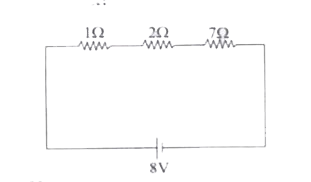A (i) series (ii) parallel combination of two given resistors is connected one by one across a cell. In which case will the terminal potential difference across the cell have higher value?
Terminal potential differnce is equal to the voltage drop across the external resistor connected to cell. As resistance of two resistors in series is more than in parallel, so the terminal potential difference will have higher value in series combination of two resistors.
Topper's Solved these Questions
- CURRENT ELECTRICITYBook:PRADEEPChapter:CURRENT ELECTRICITYExercise:Conceptual Problems
Explore 3 Videos
- CURRENT ELECTRICITYBook:PRADEEPChapter:CURRENT ELECTRICITYExercise:Very short Q/A
Explore 7 Videos
- COMMUNICATION SYSTEMSBook:PRADEEPChapter:COMMUNICATION SYSTEMSExercise:MODEL TEST PAPER-2
Explore 9 Videos
- DUAL NATURE OF RADIATION AND MATTERBook:PRADEEPChapter:DUAL NATURE OF RADIATION AND MATTERExercise:Exercise
Explore 191 Videos
Similar Questions
Draw a circuit diagram of an electric circuit containing a cell, a key, an ammeter, a resistance of 2Ω in series with a combination of two resistors (4Ω each) in parallel and a voltmeter across the parallel combination. Will the potential difference across the 2Ω resistor be the same as that across the parallel combination of 4Ω resistors ? Give reason.
View SolutionDraw a circuit diagram of an electric circuit containing a cell, a key, an ammeter, a resistor of 2Ω in series with a combination of two resistors (4Ω each) in parallel and a voltmeter across the parallel combination. Will the potential difference across the 2Ω resistor be the same as that across the parallel combination of 4Ω resistors? Give reason.
View Solution
Knowledge Check
What is the potential difference across resistor in the given circuit ?
 A80VB0VC32VD16V
A80VB0VC32VD16VIf n identicals cells, each of emf E and internal resistance r, are connected in series. If two ends of this combination of cells are joined to each other without any external resistance. What will be the terminal potential difference across each cell?
AEBE/nCzeroDcannot be determineA cell of e.m. E and internal resistance r is connected across a resistancer. The potential difference between the terminals of the cell must be
AEBE/2CE/4D3/2
Draw a circuit diagram of an electric circuit containing a cell, a key, an ammeter, a resistance of 2Ω in series with a combination of two resistors (4Ω each) in parallel and a voltmeter across the parallel combination. Will the potential difference across the 2Ω resistor be the same as that across the parallel combination of 4Ω resistors ? Give reason.
View SolutionA batery, with potential V across it, is connected to a combination of two idential resistors and them has current I through it. What are the potential difference acros and the current through either resistor if the resistors are (a) in series and (b) in parallel?
View SolutionWhat is the relationship between potential difference across the terminals of a cell and emf of the cell ?
View SolutionWhen a resistor of 5Ω is connected across a cell, its terminal potential differnce is balanced by 140 cm of potentiometer wire and when a resistance of 8Ω is connected across the cell, the terminal potential difference is balanced by 160 cm of the potentiometer wire. Find the internal resistance of the cell.
View SolutionThe potential difference across the terminals of the cell in open circuit is called as
View Solution

